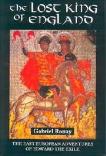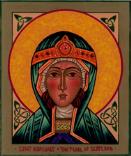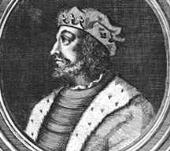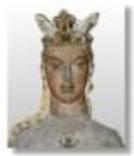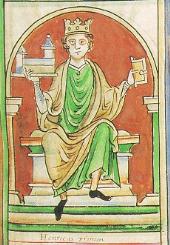See also
- Edward KING OF ENGLAND (UNCROWNED)'s parents: Edmund II Ironside KING OF THE ENGLISH (981-1016) and Ealdgyth (963-1017)
- Edward KING OF ENGLAND (UNCROWNED)'s brother: Edmund ( - )
Edward KING OF ENGLAND (UNCROWNED) (1016-1057)
1. Edward KING OF ENGLAND (UNCROWNED), son of Edmund II Ironside KING OF THE ENGLISH (981-1016) and Ealdgyth (963-1017), was born in 1016 in Kiev or Hungary. He married Agatha of Brunswick circa 1035 in London, Middlesex. He died in 1057.
Edward the Exile (1016 – February 1057), son of King Edmund Ironside and of Ealdgyth, gained the name of "Exile" from his life spent mostly far from the England of his forefathers. When only a few months old, he was sent by the usurper Canute to be murdered in Denmark, rather than on English soil. Instead, he was secretely brought to Kiev and then made his way to Hungary. On hearing the news of his being alive, Edward the Confessor recalled him to England and made him his heir. However, Edward the Exile died shortly after his return, causing a succession dispute that ultimately led to the Norman Conquest of England.
The paternity of his wife Agatha is debated: the medieval sources agree that she was a sister of Hungarian Queen, and disagree as to other details. The Anglo-Saxon Chronicle and Florence of Worcester's "Chronicon ex chronicis" describe Agatha as a blood relative of the Henry III, Holy Roman Emperor. Based on these sources, prominent genealogist Szabolcs de Vajay popularized an idea that she was the daughter of the Emperor's elder (uterine) half-brother, Liudolf, Count of Friesland (1962). Agatha's rare Greek name was recently interpreted in favour of a different version, expounded by Geoffrey Gaimar and Roger of Howden, that her father was a "Russian king", i.e. Yaroslav the Wise.
Their children included Edgar Ætheling and Saint Margaret of Scotland.
Agatha of Brunswick, daughter of Liudolf COUNT OF BRUNSWICK (c. 1016- ) and Gertrud COUNTESS OF NORDGAU (c. 1006-1077), was born circa 1018 in Braunschweig, Prussia. She died on 13 July 1024. She and Edward KING OF ENGLAND (UNCROWNED) had the following children:
| +2 | |
| +3 | |
| +4 |
Second Generation
2. Saint Margaret "the Exile", daughter of Edward KING OF ENGLAND (UNCROWNED) and Agatha of Brunswick, was born in 1045 in Hungary. She died on [Julian] 16 November 1093 in Edinburgh Castle. She married Malcolm III KING OF SCOTLAND.
Saint Margaret 'the Exile' was the daughter of Edward 'Atheling' and Agatha. She was born in 1045 at Hungary. She married Malcolm III 'Caennmor', King of Scotland, son of Duncan I 'the Gracious', King of Scotland and Sybilla of Northumbria, in 1069 at Dunfermline Abbey, Dunfermline, Fife, Scotland. She died on 16 November 1093 at Edinburgh Castle, Edinburgh, Edinburgh, Scotland. She was buried at Dunfermline Abbey, Dunfermline, Fife. She was buried at Jesuit College, Douai, France.
She was the granddaughter of Edmund Ironsides and 7th in descent from Alfred the Great
In 1250 she was canonised as Saint Margaret.
Born about 1045, Princess Margaret was a daughter of Edward "Outremere", or "the Exile", and Agatha, kinswoman of Gisela, the wife of St. Stephen of Hungary . She was the granddaughter of Edmund Ironside.
The chief authority for Margaret's life is the contemporary biography printed in Roman " Acta SS .", II, June, 320. Its authorship has been ascribed to Turgot, the Saint's confessor, a monk of Durham and later Archbishop of St. Andrews, as well as to Theodoric, a somewhat obscure monk
The Norman conquest forced the Anglo Margaret and her family to flee to Scotland in 1070 where shortly thereafter she married the King, Malcom II (Canmore). As Queen and co-Regent, Margaret bore eight children (two daughters and six sons). She was known to have been a particularly involved and good mother - a departure from the contemporary practice of leaving the rearing of children to servants and tutors. Margaret's daughter Matilda married Henry I of England , making her an ancestress of the present British royal house.
Queen Margaret was renown for her moderating and good influence on her husband and for her devout piety and religious observance. As Queen, Margaret used her influence to bring Scotland into the more modern practices, disciplines of European Christianity and is celebrated as a clerical reformer. Though strong-willed, Margaret used reason and encouragement to influence change, not her authority as co-Regent and Queen. Under Queen Margaret's leadership the Rite of the Celebration of the Mass was brought under standardized norms, the vernacular of the Mass was changed from the many dialects of Gaelic spoken throughout Scotland to the unifying Latin, the Scots began to receive Communion regularly, and the observance of Lent was improved.
Although her influence in causing the clergy to adopt Latin to celebrate the Mass was intended as a tool by which all Scots could worship in unity, along with the other Christians of Western Europe, Queen Margaret's introduction of Anglo-Norman manners and values into Celtic Scotland laid the cultural groundwork for the future induction of her land and people into a greater England and Britain. While many hagiographers view Queen Margaret's goals as not simply uniting the Scots, but Scotland and England together as a way of ending bloody warfare amongst the clannish highlanders, Scotland returned to a period of isolation immediately following her death.
In 1093, King Malcom was murdered through treachery near Alnwick and was buried at Dunfermline Abbey, which had been founded by in 1072 Margaret. She foretold the day of her death, joining her husband's eternal rest on 16 November 1093, her body being buried before the high altar at Dunfermline.
In 1250, Queen Margaret was canonized by Innocent IV, and her relics were translated on 19 June, 1259, to a new shrine, the base of which is still visible beyond the modern east wall of her restored chapel. At the Reformation her head passed into the possession of Mary Queen of Scots, and later was secured by the Jesuits at Douai , where it is believed to have perished during the French Revolution. According to George Conn, " De duplici statu religionis apud Scots " (Rome, 1628), the rest of the relics, together with those of Malcolm, were acquired by Philip II of Spain, and placed in two urns in the Escorial. When, however, Bishop Gillies of Edinburgh applied through Pius IX for their restoration to Scotland , they could not be found.
St. Margaret is remembered for her fervent faith, practiced piety and religious observance and continues to be celebrated as Scotland's most beloved saint. St. Margaret was loved by the poor, especially orphans to whom she was particularly attached in personal care and through the unceasing distribution of alms. She was the foundress of many churches, convents and monasteries, including the Abbey of Dunfermline, built to enshrine her greatest treasure, a relic of the true Cross. Her book of the Gospels, richly adorned with jewels, which one day dropped into a river and was according to legend miraculously recovered, is now in the Bodleian library at Oxford . St. Margaret's son King David of Scotland is also celebrated by the people of Scotland as a Saint.
Feast of St. Margaret of Scotland
The feast of St. Margaret is observed by the whole Roman Catholic Church on 10 June. The Episcopal Church Commemorates St. Margaret each year on the Sunday closest to the anniversary of her death November, 16 th .
This is the fast that I choose, says the Lord: to share your bread with the hungry, and bring the homeless poor into your house; when you see the naked, to cover them, and not to hid yourself from your own kin. Isaiah 58:6-7.
Malcolm III KING OF SCOTLAND, son of Duncan I KING OF SCOTLAND (c. 1001-1040) and Sybilla of Northumbria ( - ), was born circa 1031. He died on [Julian] 13 November 1093. He and Saint Margaret "the Exile" had the following children:
| +5 | |
| +6 |
3. Edgar "Aetheling" PRINCE OF ENGLAND, son of Edward KING OF ENGLAND (UNCROWNED) and Agatha of Brunswick, was born circa 1051. He died circa 1126. He married Margaret of Scotland.
Edgar Ætheling or Eadgar II (c. 1051 – c. 1126) was proclaimed, but never crowned, King of England. He was the last member of the Anglo-Saxon royal house in the Kingdom of England. Born in Hungary, he was also known as Edgar the Outlaw. The Anglo-Saxon name Atheling or, as it was spelled during the Anglo-Saxon period, Æþeling, means "man of noble blood, chief, prince" and was used in the later part of the period to designate specifically the sons of the king. Proclaimed king by the witan following the death of Harold II in the Battle of Hastings on October 14, 1066, Edgar was never crowned and submitted to William I some eight weeks later. He was only about thirteen or fourteen years old.
Edgar was the only son of Edward the Exile, heir to the English throne, and grandson of King Edmund II Ironside. Upon his father's death in 1057, Edgar was nominated as Heir Apparent by the king Edward the Confessor. Edgar was brought up at Edward's court, together with his sisters, Saint Margaret of Scotland and Christina. However he was too young at the time of the king's death in January 1066 to defend the country against impending invasion, and his election as king after Harold's death was no more than a symbolic token of defiance against the invading Norman forces.
Edgar relied largely for his support upon Archbishop Stigand and upon Earls Edwin of Mercia and Morcar of Northumbria and, when this weakened within a matter of days of the witan, Edgar was forced inevitably to submit to William at Berkhamstead in either late November or early December 1066.
William treated Edgar well. Seeing political advantage, he kept him in his custody and eventually took him back to his court in Normandy. However, Edgar joined in the rebellion of the earls Edwin and Morcar in 1068 and, though defeated, he fled to the court of Malcolm III of Scotland. The next year Malcolm married Edgar's sister Margaret, and agreed to support Edgar in his attempt to claim the English crown. In exchange, Edgar married Malcolm's sister, another Margaret. Edgar now made common cause with Sweyn Estridson, the king of Denmark and nephew of Canute, who believed he was the rightful king of England.
Their combined forces invaded England in 1069. They captured York, but did not proclaim the independence of Northumbria. William marched on the north, devastating the land as he went. He paid the Danes to leave, whilst Edgar fled to Scotland. He remained in refuge there until 1072 when William successfully enforced a peace treaty on Malcolm, the terms of which included the exile of Edgar. Edgar eventually made his peace with William in 1074 but he never fully gave up his dreams of regaining the throne of England. He supported Robert, Duke of Normandy, against William II in 1091 and again found himself seeking refuge in Scotland. He also supported his nephew, Edgar, in gaining the Scottish throne, overthrowing Donald III.
Around 1098 he went to Constantinople, where he may have joined the Varangian Guard of the Byzantine Empire. Later that year he was given a fleet by Emperor Alexius I to assist in the First Crusade, and brought reinforcements to the crusaders at the Siege of Antioch. He was taken prisoner at the Battle of Tinchebrai in 1106 fighting for Duke Robert against Henry I. He returned to England where Henry pardoned him, and he retired to his country estate in Hertfordshire. His niece Edith (renamed Matilda) had married Henry I in 1100. Edgar is believed to have travelled to the Kingdom of Scotland late in life, perhaps around the year 1120, and was still alive in 1125, but may have died soon after, in his early seventies. By then he was forgotten by most and is remembered now only as the "lost king" of England.
Margaret of Scotland was the daughter of Duncan I KING OF SCOTLAND (c. 1001-1040) and Sybilla of Northumbria ( - ).
4. Christina PRINCESS OF ENGLAND (UNCROWNED) was the child of Edward KING OF ENGLAND (UNCROWNED) and Agatha of Brunswick.
Third Generation
5. Editha of Scotland (known as 'Matilda'), daughter of Malcolm III KING OF SCOTLAND and Saint Margaret "the Exile", was born circa 1079 in Dunfermline, Fife, Scotland. She had the title 'Queen Consort Matilda'. She married Henry I KING OF ENGLAND on [Julian] 11 November 1100. She died on [Julian] 1 May 1118 in Westminster Palace.
Sister of Edmund, Edgar and David I (The Saint) Kings of Scotland. As of 11 November 1100, her married name was Queen Consort Matilda of England.
Henry I KING OF ENGLAND, son of William I KING OF ENGLAND (c. 1027-1087) and Matilda de Flandre (1032- ), was born in [Julian] September 1068. He married Adeliza of Louvain on 2 February 1121. He died on [Julian] 1 December 1135. He was buried in Westminster Abbey. He and Editha of Scotland had the following children:
| 7 | Matilda of Normandy EMPRESS OF ENGLAND (c. 1102-1167). Matilda was born circa [Julian] August 1102. She died on [Julian] 10 September 1167. |
6. Mary of Scotland, daughter of Malcolm III KING OF SCOTLAND and Saint Margaret "the Exile", married Eustace III EARL (COUNT) OF BOLOINE.
Eustace III EARL (COUNT) OF BOLOINE, son of Eustace II, Gernobadatus EARL (COUNT) OF BOLOINE (c. 1030-1087) and Ida von Niederlothringen (of Moselle & Lorraine) (1040-1113), died circa 1125. He and Mary of Scotland had the following children:
| 8 | Matilda de BOULOGNE ( -1151). Matilda died in 1151. |
